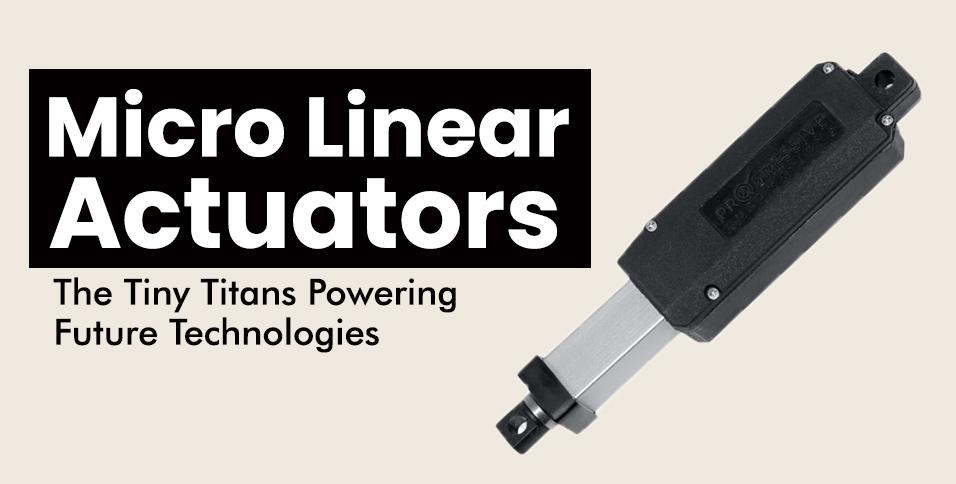Micro linear actuators, often no larger than the size of a penny, are engineering marvels that offer precise linear displacement in small-scale applications. They are devices that create motion in a straight, linear path, unlike rotational motion in a circular path. Operating on diverse principles, a micro linear actuator converts various types of energy, such as thermal, electrical, or mechanical into linear motion. In a world of ever-shrinking technologies, these tiny but powerful components serve as the muscle behind miniature systems, allowing us to build compact devices without sacrificing performance.
Learn the Types of Micro Linear Actuators
Piezoelectric Actuators
Piezoelectric systems are fascinating components using the piezoelectric effect to achieve precise movements. In these devices, an applied electrical voltage induces mechanical strain in piezoelectric materials, creating motion. Known for their incredible precision and rapid response times, these actuators have been integral to fields such as microelectronics and biotechnology.
Electromagnetic Units
Electromagnetic systems operate based on the magnetic forces produced by electromagnetic fields. By passing a current through a coil, a magnetic field is generated that can move ferrous materials. Notable for their high speed and force, these types of units find wide-ranging applications from valve control in manufacturing to vibration generation in mobile phones.
Thermal Drivers
Thermal actuators utilize the principle of thermal expansion to create motion. As heat is applied to a material, it expands, leading to a displacement. This can be harnessed to create a linear motion. These devices, offering simplicity and quiet operation, are often used in systems where low noise levels are essential, such as optical devices.
Comparing the Types – Strengths and Weaknesses
Each type of small device of linear motion comes with its own set of strengths and weaknesses. Piezoelectric actuators excel in precision and speed, but their displacement range is relatively short. Electromagnetic devices can provide substantial force and rapid action, but they typically consume more power and may interfere with sensitive electronic devices due to their magnetic field. On the other hand, thermal units are simple and quiet but are typically slower and less precise compared to the other types due to the time required for heating and cooling. The choice of the actuator depends on the specific requirements of the application at hand.
Working Principle of Linear Actuators of Compact Size
Understanding Basic Mechanism
At the heart of a micro linear unit is a simple yet profound principle: the conversion of one type of energy into mechanical energy, which is then used to create linear motion. Depending on the type of actuator, this energy can be electrical, thermal, or electromagnetic. The central component of a linear device, the ‘motor’, generates the force required to create motion.
Power Source and Control Inputs
Micro-linear devices are typically powered by electricity, although the exact nature of the input can vary significantly based on the type of actuator. For example, a piezoelectric actuator requires a voltage, while an electromagnetic device requires an electric current. The control inputs also differ based on the actuator type. Some units can be controlled simply by switching the power on and off, while others might require more complex inputs such as pulse-width modulation or specific voltage levels.
Actuation and Movement
The actuation process begins when the control input instructs the actuator to move. The input signal triggers the motor mechanism to generate force. This force is then translated into motion by the drive mechanism. The resulting motion can be highly precise, with some devices capable of producing movements as small as a few nanometers. It’s important to note that most micro linear actuators can control both the direction and the speed of movement, making them incredibly versatile tools in many different applications.
Potential Impact of Micro Linear Devices on Future Technologies
As technology continues to evolve at a breakneck pace, the role of micro linear actuators is set to expand and become even more critical. Their small size, coupled with their precision and efficiency, makes them perfect candidates for a range of future technologies.
- Nanotechnology: The system can provide precise movement at the nanoscale, critical for advancements in nanorobotics and nanosensors.
- Advanced Robotics: These actuators offer the precision needed in small, complex robots, key to areas like robotic surgery and nano-robotics.
- Internet of Things (IoT): The devices could enable IoT devices to interact with the physical world more intricately as IoT expands.
- Space Exploration: In the pursuit of compact, efficient spacecraft, these linear motors could be vital, finding uses in precision instruments and deployment mechanisms.
- Healthcare and Biotechnology: In healthcare, micro linear actuators can enable less invasive, more effective diagnostic instruments and treatment methods.
While the potential applications are incredibly diverse, one common thread is clear: micro linear devices are set to play an important role in the future of technology, helping to drive innovations in fields from medicine to space exploration.
Also Read: How Smart Farming Is Renovating Traditional Farming Methods And Tools?















